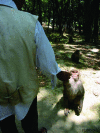Temple monkeys and health implications of commensalism, Kathmandu, Nepal
- PMID: 16707044
- PMCID: PMC3373059
- DOI: 10.3201/eid1206.060030
Temple monkeys and health implications of commensalism, Kathmandu, Nepal
Abstract
The threat of zoonotic transmission of infectious agents at monkey temples highlights the necessity of investigating the prevalence of enzootic infectious agents in these primate populations. Biological samples were collected from 39 rhesus macaques at the Swoyambhu Temple and tested by enzyme-linked immunosorbent assay, Western blot, polymerase chain reaction, or combination of these tests for evidence of infection with rhesus cytomegalovirus (RhCMV), Cercopithecine herpesvirus 1 (CHV-1), simian virus 40 (SV40), simian retrovirus (SRV), simian T-cell lymphotropic virus (STLV), simian immunodeficiency virus (SIV), and simian foamy virus (SFV). Antibody seroprevalence was 94.9% to RhCMV (37/39), 89.7% to SV40 (35/39), 64.1% to CHV-1 (25/39), and 97.4% to SFV (38/39). Humans who come into contact with macaques at Swoyambhu risk exposure to enzootic primateborne viruses. We discuss implications for public health and primate management strategies that would reduce contact between humans and primates.
Figures



Comment in
-
Viruses from nonhuman primates.Emerg Infect Dis. 2006 Nov;12(11):1802-3; author reply 1803. doi: 10.3201/eid1211.060659. Emerg Infect Dis. 2006. PMID: 17285707 Free PMC article. No abstract available.
References
-
- Fuentes A, Southern M, Suaryana KG. Monkey forests and human landscapes: is extensive sympatry sustainable for Homo sapiens and Macaca fascicularis on Bali? In: Patterson J, Wallis J, editors. Commensalism and conflict: the human-primate interface. Norman (OK): ASP Press; 2005. p. 165–95.
Publication types
MeSH terms
Substances
Grants and funding
LinkOut - more resources
Full Text Sources
Other Literature Sources
Medical
